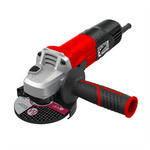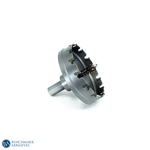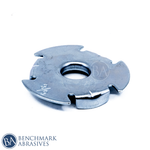
Wire Brushes: Common Problems and How to Fix Them

Wire brushes serve as a crucial tool for a number of industries and DIT applications due to their effectiveness in cleaning, surface preparation, deburring, and finishing. Their flexibility is evident as they may be used to remove paint and rust and create textured surfaces. But wire brushes, like any abrasive tools, are capable of experiencing a number of problems that can affect their performance, reduce durability, and even lead to safety risks if left unsecured.
This blog includes an overview of how to solve typical issues with wire brushes. By understanding common problems like wire breakage, improper cleaning, quick wear, and surface damage, users can learn to determine the root causes and implement effective solutions. With this information, you'll be able to easily maintain and handle your wire brushes, which ensures the most favorable results on each task.
Wire Brushes: What Are They?
A wire brush is an attachment for a hand or power tool featuring strong metal wire bristles. These wires are especially made of steel, nylon, or brass, depending on the purpose of use. The bristles are attached to a handle (wood or plastic for hand brushes) or a hub (wheel, cup, or end brush for power tools).
Wire brushes are highly versatile as they can be used for a wide range of applications, including surface preparation, cleaning, deburring, polishing, etc., and different industries, including Automotive, manufacturing, construction, woodworking, welding, and food service.
Common Problems And Solutions Of Wire Brushes
Here is the list of common problems experienced with wire brushes and their troubleshooting tips:
1. Ineffective Cleaning/Material Removal
It can be challenging to use a wire brush for cleaning when dirt, paint, rust, or other pollutants cannot be removed from the surface. There are a number of causes, most of which are linked to the condition of the brush or the type of method you are using.
- Old or Worn-Out Brush: The brush with dull, bent, or broken bristles will naturally fail its scrubbing and abrasive power as it gets old or worn out. Hence, it will be challenging to remove contaminants from the surface, causing ineffective results.
- Incorrect Type Of A Brush: Choosing the incorrect type of wire brush for a particular task can also cause poor results or failure. For example, using a too soft wire brush might slide over tough pollutants; on the other hand, using a too coarse wire brush will not make enough contact on uneven surfaces.
- Inappropriate Speed: Incorrect speed can also affect the performance of the wire brushes. When it comes to speed, applying too high a speed can cause damage to the surface, or there is a chance of skipping. Applying too low a speed, on the other hand, cannot be effective in eliminating dirt and other contaminants.
- Inappropriate Pressure: When it comes to pressure, applying too much pressure can reduce the scrubbing action, while applying too low pressure can not make enough contact with the surface.
- Accumulation of Debris on the Surface: Accumulation of debris can clog the bristles, which can lead to a poor surface finish.
TROUBLESHOOTING STEPS
- Ensure to replace old or worn brushes to avoid ineffective cleaning.
- Ensure to choose the right type, including cup, wheel, or end brushes that suit the task you are doing
- Maintain optimal speed and pressure.
- Ensure to clean the brushes thoroughly after each use to eliminate accumulated debris on the surface.
2. Rusting Of Bristles
Rusting of wire brush bristles is a common cause, especially with carbon steel brushes, which is caused by the appearance of reddish-brown iron oxide on the wire surfaces. The bristles become more fragile due to this process of corrosion, which results in a decrease in the effectiveness and durability of the brush. The following are the common causes of rusting:
- Wet Storage: The major cause of rusting is exposure to moisture and oxygen, usually occurring from incorrect storage in wet or humid conditions.
- Using Corrosive Chemicals: Wire brushes are more likely to rust or degrade rapidly when used with corrosive chemicals, mainly when bristles are made of carbon steel. Corrosive chemicals have a propensity to react with the wire's metal, which speeds up the oxidation process that results in the creation of rust.
- Using The Brush on Corrosive Materials Without Cleaning: If the brush is used on corrosive or wet materials and it does not get cleaned properly after the process, it can leave behind moisture and reactive particles that speed up the rusting process.
TROUBLESHOOTING STEPS
- Ensure to store wire brushes in clean and dry areas to prevent moisture absorption, which can cause rust.
- Ensure to thoroughly clean the brushes after each use on corrosive materials to prevent rusting.
- Make sure to use rust-resistant or stainless-steel wire types for working with corrosive materials.
3. Rapid Wear Of A Brush
Rapid wear is the term used to describe the quick degradation of a wire brush wherein the bristles can break, become severely worn, or get distorted in a short span of use. This can lead to decreasing the lifespan of a brush and increasing operating expenses. The following are the factors that cause rapid wear of wire brushes:
- Excessive Operating Speed: Using the brush at high speed produces friction and heat, which can weaken the wires and result in quick wear or tear
- Inappropriate Storage: This can also cause rapid wear of wire brushes because of storing the brushes in damp or corrosive environments, which leads to rust or chemical degradation.
- Continuous Use Without Taking Breaks: Using wire brushes for a longer period without taking breaks can lead to overheating and weaken the metal.
- Compatibility of Brush and Material: Using the incorrect brush for specific materials can cause rapid wear.
TROUBLESHOOTING STEPS
- Ensure you choose the correct wire material for the surface
- Ensure that your brush and material are not too hot. Take a break from the process and let the brushes or material cool down to prevent rapid wear.
- Always make sure to store the brushes in a cool and dry area.
- Ensure to maintain the recommended speed setting.
4. Surface Damage
Undesired changes to the workpiece, like scratches, gouges, or an extremely rough finish, can cause surface damage from a wire brush. This unfavorable result often occurs due to the following factors:
- Using a Too Hard Brush: using too hard or too aggressive material can cause surface damage.
- Applying Excessive Pressure: applying too much pressure or forcing the wire tips deeper into the material’s surface can cause scratches and damage the surface
- Incorrect Operating Speed: Uncontrollably high or irregular operation speeds might result in gouging and abrasion.
- Damaged Or Misaligned Bristles: Broken or bent bristles can also cause surface damage by inadvertently penetrating the material at odd angles.
TROUBLESHOOTING STEPS
- Ensure to select a brush with the correct type of wire and hardness that is perfectly suitable for the material being operated.
- Ensure to apply gentle pressure to prevent surface damage
- Ensure to maintain a consistent and appropriate operating speed to prevent gouging and abrasion.
- Ensure to examine brushes regularly for any damage, bent bristles, or misalignment of bristles to prevent surface damage.
5. Overheating
Overheating of the workpiece as well as the wire brush is a crucial problem that arises during long and intense use, which arises due to the heat and friction generated between the moving or spinning wires and the surface being brushed. The following are the causes of overheating:
- High speed: Operating at extremely high speeds is the primary cause of overheating. This generates significant friction, leading to a rapid buildup of thermal energy that can damage both the wheel and the material.
- Applying too much pressure: Applying too much pressure forces the wires against the material more aggressively, which can cause friction and lead to overheating.
- Continuous use for longer hours: continuous use of a brush for a longer duration without allowing the brush to cool down will lead to heat accumulation and eventually cause overheating.
TROUBLESHOOTING STEPS
- Ensure to apply gentle and consistent pressure to avoid overheating and damaging the wire brushes.
- Ensure to check the manufacturer’s guidelines for using wire brushes at different speeds.
- Give the wheel and material time to cool down between processes to prevent overheating.
6. Wire Breakage
When using wire brushes, the most common problem that you experience is wire breakage, which refers to the cracking of individual bristles during operation. This will result in minimizing the effectiveness of the brush, reducing its durability, and can lead to flying wire fragments, which further lead to safety hazards. The following are the reasons that can cause issues with wire brushes:
- Applying Too Much Pressure: Exerting too much pressure can force the wires beyond their flexural limit, causing premature failure or wire damage.
- Excessive Operating Speed: Excessive operating speed can also cause damage to the wire brush or the material.
- Using an incorrect wire type for the material: Employing a wire type that is inappropriate for the hardness of the material being processed can also lead to breakage because tougher materials can overexert weaker wires.
- Old or worn-out brush: Brushes can become brittle over time, causing damage.
- Improper storage: storing brushes in a humid or wet environment can cause corrosion, breakage, and weakening of the wires.
- Poor quality of a brush: Brushes made of low or poor materials can also lead to breakage of wires, causing damage to the material or poor results.
TROUBLESHOOTING STEPS
- Ensure to select the right wire material to prevent wire breakage.
- Before using the brushes, make sure to check them for damage and replace any worn-out or damaged brushes.
- Make sure to work at the recommended speed and apply gentle pressure while working with wire brushes.
7. Vibration And Imbalance Of Wire Brushes
The extreme shaking or wobbling that occurs when power tool wire brushes are vibrated or unbalanced can cause operator fatigue, a loss of control over the tool, uneven surface treatment, and even harm to the brush and the power tool itself. The following are the contributing factors behind vibration and imbalance:
- Bent or Damaged Brush: One of the major causes behind vibration or imbalance is a damaged or bent brush, wherein the deformation throws off the rotational balance and even mass distribution.
- Incorrect Mounting of the Brush: Unbalance can also be introduced by improperly mounting the brush onto the arbor or spindle of the power tool, particularly if the clamping mechanisms are loose or misaligned.
- Uneven Wear of the Brush: Vibrations can be caused by uneven wear across the brush face, which occurs due to uneven pressure application or working on uneven surfaces.
- Loose wires causing imbalance: Loose or broken wires inside the brush can lead to imbalance.
TROUBLESHOOTING STEPS
- Ensure regular inspection of the wire brushes for any signs of damage or bent brushes, and replace them immediately for enhanced performance.
- Make sure your brush is securely attached to your power tool. Always check the manufacturer's instructions for the correct way to mount it.
- Ensure to apply even pressure while using wire brushes to avoid uneven wear.
- Replace the wire brush if there are any loose wires to enhance balance.
Tips For Maintaining Wire Brushes
To keep your wire brushes in top shape, follow these general tips:
- Clean After Each Use: Ensure that the brush is cleaned thoroughly after working with corrosive materials to enhance the durability of the wire brush. For cleaning bristles and hubs, use compressed air, a degreaser, or a cleaning tool for a wire brush.
- Proper Storage: Be sure to store wire brushes in a clean, dry place to avoid moisture and dust, which can cause rust or corrosion. You can also keep the brushes in their ideal packaging or in a container to avoid the bending of bristles or damage.
- Test First: Test the wire brush on a scratchy material to see if you are getting the expected outcomes. This will make sure that your important workpiece is safe from getting any damage.
- Wear Appropriate Protective Gears: Make sure to wear proper protective gear prior to working with wire brushes to ensure safety and smooth performance.
- Follow the manufacturer’s guide: Ensure you check the manufacturer’s guidelines for operating speed and its applications.



































































